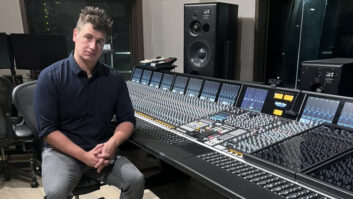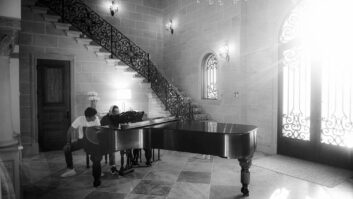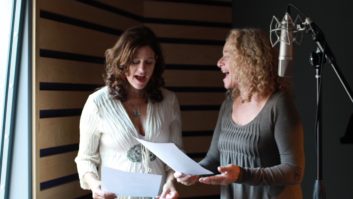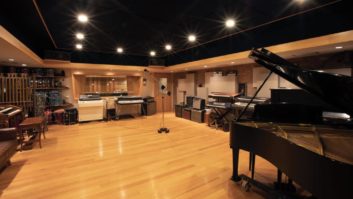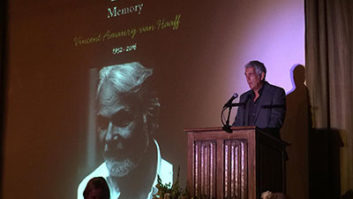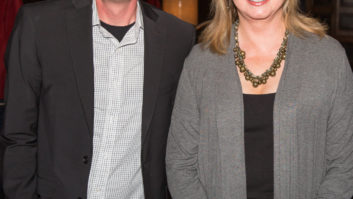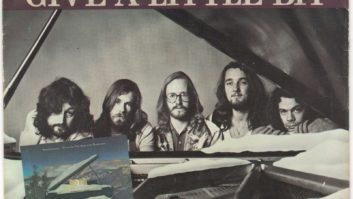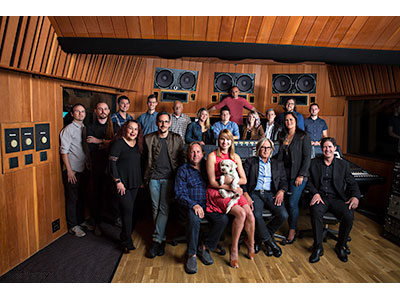
The Village staff, in Studio D. Front row, L to R: Dina Ayala, CFO; Noel Zancanella, Private Client; Ed Cherney, Private Client, Julie Jurenas, executive assistant; Jack, studio dog; Jeff Greenberg, Owner; Tina Morris, Studio Manager; John Alagia, Private Client. Back Row, L to R: Gabe Burch, engineer; Alex Williams, senior engineer; Bryant Lewis, assistant engineer; Jeff Gartenbaum, senior engineer; Frankie Romo, maintenance; Vanessa Parr, senior engineer; Karl Wingate, tech and assistant engineer; Ghian Wright, senior engineer; Kelsey Worley, executive assistant; Spencer Fuller, chief tech; Matt Dyson, engineer; Billy Centenaro, engineer.
Photo: Chris Schmitt.
Today, it’s simply known as The Village. There is no Recorders, Recording or Studios following the name, as there has been since Geordie Hormel opened a 24-track studio in a former Masonic Lodge in 1968 in West Los Angeles. Over the ensuing decades, studios were added, hundreds of hit records were made, new markets opened up and all three stories were filled out. But the name got shorter; the brand stands on its own. Simply The Village.
And there couldn’t be a more apt moniker for what Hormel and, starting in 1995, Jeff Greenberg have created. The studios, particularly A and D, speak for themselves, having hosted sessions for the likes of the Rolling Stones, Steely Dan, Frank Zappa, Neil Diamond, Moby, Guns N’ Roses, Coldplay and so many others. It’s where Eric Clapton wrote “Tears In Heaven.” But behind the scenes, built into the bones of the building in a series of private rooms, is an in-house collection of producers, artists and engineers that form the lifeblood of the operation. Lots of studios have played with the model of resident artists and creative talent, but nobody in the world has made it work like The Village. For many, many years.
“It was really Geordie Hormel, the founder of the Village, who started the idea of resident clients,” says Greenberg, now the owner. “Way before me there were people like Skunk Baxter, Robbie Robertson, Pat Williams and Mark Hudson in-house. When I got here there was already a tradition, and I certainly saw the benefit of having all of these creatives in the building. And then I have to give credit to Mike Knobloch, who for the music on Master and Commander came in and rented five rooms at a time for composers to work. We developed these spaces for that film, and that was followed by Keb Mo, then Jimmy Jam and Terry Lewis from Minneapolis, and now so many others we’ve had through the years.
“But even before that, I have to give credit to Al Schmitt,” Greenberg continues. “When I came on in 1995, the studio was on the verge of liquidation. It needed a resurrection. Al came over and spent two years with us, picking out equipment, finding the 8048 in Studio A, then working with Neve on the development of the 88R. He really made it professional. Then there is Thomas Newman, who really helped us develop in film music, starting with Shawshank Redemption. T Bone Burnett is a member of the family and has pushed me over the years to create new spaces. The Moroccan Room [pictured on this month’s cover] was his inspiration and it’s now one of the great live rooms in town. Then Ed Cherney, John Alagia—these guys demand the highest level of expertise. We feel very blessed. It’s a small family. And now we have a waiting list of people who would like to call The Village home! There’s a real energy in this building.”
The advantages for the in-house producer and engineer are apparent: a professional infrastructure, the opportunities for collaboration and free Starbucks. “I first set up my writing room at The Village in the mid-’80s,” recalls Robbie Robertson. “I think I was the first one to have my own space there. I felt that it would be really efficient if I could write and record whenever I wanted to, and have easy access to the great techs and engineers. If I wanted to record a song, all I needed to do was go downstairs to work in one of their great studios. Jeff Greenberg has really transformed the place and taken this concept and run with it.”
“I think the thing about The Village that fosters such a sense of community is Jeff,” adds engineer/producer Ed Cherney. He is warm, smart, funny, and very giving and generous. In many ways the whole scene at The Village is an extension of his personality. He supports the up and comers—artists and producers, engineers, managers and anybody else that has the desire and is willing to work hard. We had built a mix room in our house. It was cool for a minute, but then got lonely. I was mixing an album, Rolling Stones, I think, and Rose [Mann Cherney] asked me how many times I was going to listen to the song that I was working on. That’s when I knew it was time to move the studio. I happened to be doing a date at The Village soon after, and Jeff mentioned he had a room available—the Dixie Chicks had been using it as a nursery while recording an album. It had bay windows that opened with a beautiful light and sea breeze. I moved in and I hope nobody’s going to move me out.”
Meanwhile, for the Village, perhaps the biggest advantage of having in-house talent is in the exposure to new artists and extension of the community. Tina Morris, studio manager, joined the staff as a runner/tech in 1996, out of Berklee. She says, “The in-house residents are constantly bringing in new artists to see the place, sort of like with our special events. They’re inspired, and they’ll go back to their label and say they want to record at the Village. The vibe that these residents bring, and the way they develop these new artists, is a huge part of The Village day to day. I always assure them that we have the right staff to really nurture a new artist, with the same consideration we give to more seasoned artists. You never know who is going to walk through your door. Every artist is special.”

To run a multi-room professional studio today, there has to be a regular influx of new artists, many of them from a generation that hasn’t been exposed to facilities like The Village, and what they bring to a recording project. Besides benefiting from relationships with in-house clients, The Village has reached out actively through special events and broadcasts, pioneering the concept for radio and now taking up with streaming.
“I’m a promoter, so one of the first things we did when I came on was live broadcasts, with organizations like Morning Becomes Eclectic at KCRW,” Greenberg says. “I think we’re known for having new bands coming to town and playing live on the radio, or streaming. I don’t think anybody has done as many as we have. We blow their minds with how good it sounds, and many of the projects we do live end up being released as records. That’s one of the reasons we’re getting so many great new artists.”
The Village continues to thrive. The film score tracking and mixing is now a big chunk of the business, with composers, producers and engineers like T Bone Burnett, Thomas Newman, Harry Gregson-Williams and John Kurlander as regular clients. And last week two rock bands, Mel Brooks and an audio book project were all in working in the main studios. Morris has seen an increase in lockouts over the past several years, for month-long bookings, while at the same time juggling the occasional “couple of hours” for a vocal fix. Same as it ever was.
The difference is in the sense of community, and the constant flow of talent in the doors. That takes a long time to develop, with deals done on handshakes and a nod, and nobody does it better than Jeff Greenberg.
“It’s a familial, collaborative, collegial and creative relationship,” says Greenberg in summary. “There’s more great music coming out today than at any time in my life. And they are coming out of garages and bedrooms, too. I love it. But after the initial move to go home, I think professionals like to be with other professionals. And they like to work in professional spaces. Everybody is here because they love music. The people still here, the people coming up, we all love music. How lucky are we all to be doing this?”
